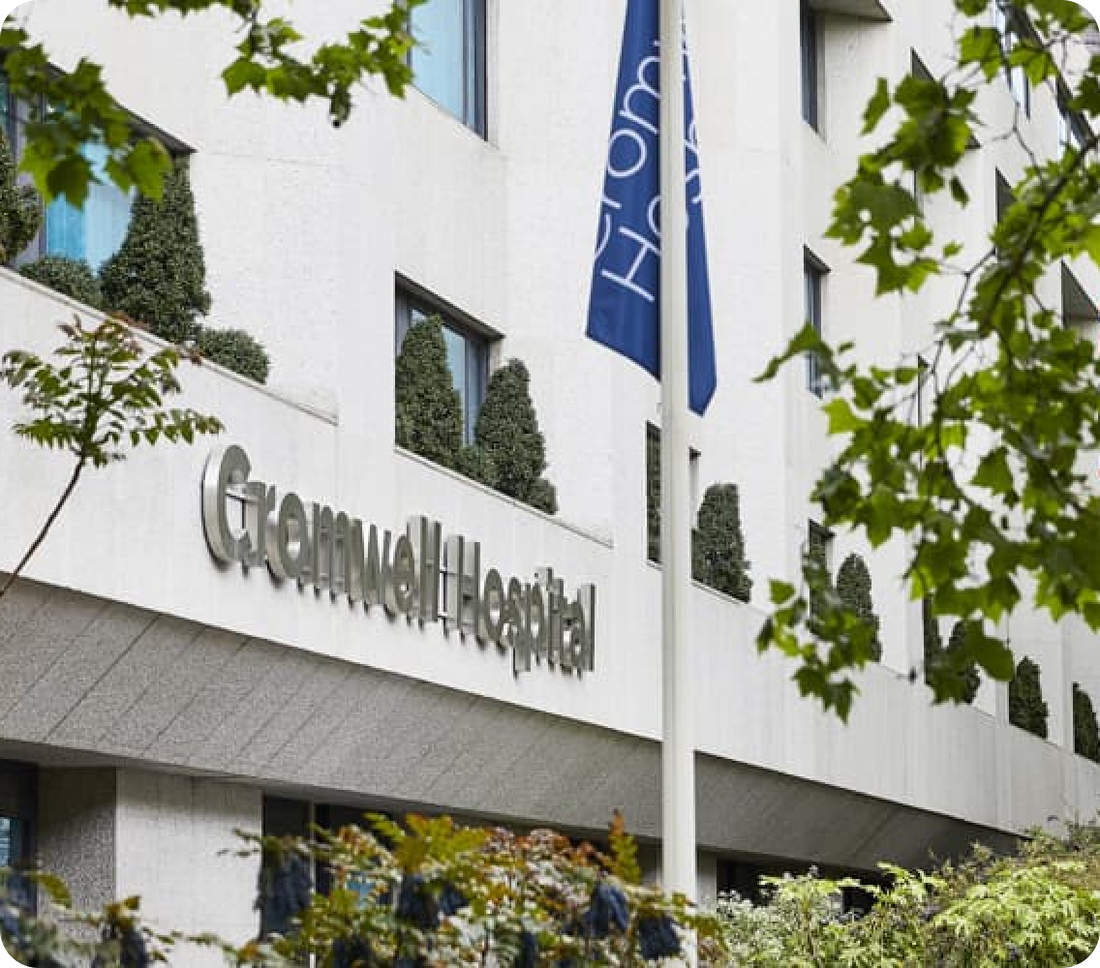Traditional Hip Replacement Summary
- Waiting Time Weeks
- Typical Stay 1 night
- Procedure Time 30 minutes
- Anaesthetic General or Spinal
- Health Insurance No
- Self-Pay Yes
Why would someone

A THR is commonly offered to patients who suffer from severe debilitating pain due to:
- 1 Osteoarthritis - degenerative hip disease Click here to watch video.
- 2 Inflammatory joint disease - such as rheumatoid, psoriatic joint disease, Systemic lupus erythrematosus, Sjogren syndrome, Systemic Click here to watch video.
- 3 Post-traumatic - arthritis Click here to watch video.
- 4 Osteonecrosis - bone death caused by loss of blood supply to the hip following dislocation
- 5 Childhood hip disease - hip dysplasia, Perthe’s disease, slipped upper femoral epiphysis (SUFE)
At Oveli Healthcare, we are committed to providing wholistic treatment for our patients. A THR is only recommended if all non-operative measures have been exhausted, such as optimising pain medication, physiotherapy, weight loss and the use of the latest injectable therapies.
Testimonials
Listen to real stories, from real patients
What does the surgery entail?

The surgeon performs an open procedure during which the diseased parts of the hip are removed. There are a variety of different ‘surgical approaches’ to enable your surgeon to gain access to the hip. At Oveli Healthcare we offer the ‘posterior’ and ‘Modified Rottinger’ approaches which come to the hip from behind or in front of the joint, respectively. Your surgeon will explain the potential benefits and limitations of each approach and you would be at the centre of that decision.
The diseased parts of the joint are replaced with new, artificial components that mimic the function of the original hip joint. There are a variety of materials used, the choice of which is guided by your physiological age and your desired functional demand. Metal components are implanted into the socket (the acetabular cup) and the bone (the femoral stem). These can be:
- Uncemented titanium implants that are coated with modern porous material that enable your bone to grow directly onto the component
- Cemented implants (plastic cup and stainless steel stem) that are firmly held in position by using a polymethylmethacrylate (PMMA) grout
- Hybrid THR that uses a titanium uncemented cup and a stainless-steel cemented stem
- Stainless steel ball with a plastic liner
- Ceramic ball with a plastic liner
- Ceramic ball with a ceramic line
The cup has either an incredibly hard modern plastic or a ceramic liner. The joint (bearing) surface can either be:
What Is The Process For The Surgery?

Welcome to our world-class hospitals, where excellence in healthcare is our guiding principle. Our facilities blend cutting-edge technology with compassionate care to provide you with the best possible experience.
With your comfort as our top priority, our hospitals are designed to make your path to recovery as smooth and pleasant as can be. Come, take a glimpse into our healthcare sanctuaries and experience the exceptional care you deserve.
- Speak with your surgeon and other healthcare team members about what to expect. Request written information or learn more about the procedure by visiting one of the websites listed in our Related Resources section. Click here to watch video.
- Ask your surgeon about exercises you can perform to strengthen your core, upper body, and leg muscles before surgery. Click here to watch video.
- If you smoke, try to quit or cut back on the amount you smoke. Click here to watch video.
- If you are overweight, try to lose weight. Being overweight can increase the risk of complications during or after surgery.
- Arrange for transportation for your procedure and follow-up visits with the surgeon.
- Ask for help around the house for a week or two after coming home from the hospital or surgical centre. This may include help with cooking, shopping, and laundry.
- Prepare for meals in advance.
-
Set up an area in your home where you will spend most of your time recovering. You may want to:
- Keep the television remote control, telephone, cell phone, medicine, tissues, and wastebasket close by.
- Place other items you use every day at arm’s level so you can easily reach them.
- Wear an apron with pockets for carrying things around the house. This leaves hands and arms free for balance or to use crutches.
- Use a long-handled “reacher” to turn on lights or grab things that are beyond arm’s length.
-
Speak to your health care team about equipment that may help with daily activities such as:
- Raised toilet seat.
- Shower chair or bench to use during bathing.
- Assistive devices to help you move around, such as a walker or crutches.
Testimonials
Listen to real stories, from real patients
Who is the surgeon?

Mr Breck Lord MA(cantab) MBBS PhD FRCS(Tr&Orth)
Mr Kristian Kley
Our Hospitals

Cromwell Hospital
London

Harley Street Specialist Hospital
London
Welcome to our world-class hospitals, where excellence in healthcare is our guiding principle. Our facilities blend cutting-edge technology with compassionate care to provide you with the best possible experience.
With your comfort as our top priority, our hospitals are designed to make your path to recovery as smooth and pleasant as can be. Come, take a glimpse into our healthcare sanctuaries and experience the exceptional care you deserve.
Pricing
Discover our comprehensive pricing options, where you can choose between two tailored plans to perfectly suit your needs while ensuring top-quality healthcare.
- Access to Oveli Patient Portal
- Pre-operative diagnostics including X-Ray
- Pre-operative assessment prior to admission
- Nursing care
- Catering during your day
- Operating theatre charges
- Drugs and dressings
- Post-operative surgeon consultation
- Post-operative routine physio appointment
- Physio protocol guide
- 2 week nurse follow-up
- 6 week consultant follow-up
Essential Care Package from £14,999
- Access to Oveli Patient Portal
- Pre-operative diagnostics including X-Ray
- Pre-operative assessment prior to admission
- Nursing care
- Catering during your day
- Operating theatre charges
- Drugs and dressings
- Post-operative surgeon consultation
- Post-operative routine physio appointment
- Physio protocol guide
- 2 week nurse follow-up
- 6 week consultant follow-up
- Select your hospital
- Pre-operative physio virtual consultation
- Fast-track, priority admission
- Transport arranged (within 60 miles)
- Post-operative 2-night stay at 5* hotel
- 6 x post-operative physio sessions
- 6 month consultant follow-up
- 12 months access to Oveli360 wellbeing hub
360 Care Package from £19,999
Is £14,999 un-affordable?
We have finance options available, or you could consider a traditional hip replacement.


Pricing
Discover our comprehensive pricing options, where you can choose between two tailored plans to perfectly suit your needs while ensuring top-quality healthcare.
- Access to Oveli Patient Portal
- Pre-operative diagnostics including X-Ray
- Pre-operative assessment prior to admission
- Nursing care
- Catering during your day
- Operating theatre charges
- Drugs and dressings
- Post-operative surgeon consultation
- Post-operative routine physio appointment
- Access to Oveli Patient Portal
- Access to Oveli Patient Portal
- Access to Oveli Patient Portal
- Access to Oveli Patient Portal
- Pre-operative diagnostics including X-Ray
- Select your hospital
- Pre-operative physio virtual consultation
- Fast-track, priority admissionTransport arranged (within 60 miles)
Essential Care Package from £14,999
360 Care Package from £19,999
Is £14,999 un-affordable?
We have finance options available, or you could consider a traditional hip replacement.


FAQs
Explore our FAQs to find answers to common questions and gain a deeper understanding of our surgery.
No - If you are fit and well enough to undergo the procedure then you will be offered the surgery irrespective of your age. Your surgeon will guide you through your own personalised risk profile. A referral for a ‘High Risk Anaesthetic Assessment’ will be made if your surgeon believes that, in order to perform the surgery safely, your medical conditions warrant further assessment.
At your surgical consultation
- Standing X-rays of your hip will be performed. These will aid diagnosis and management of your condition. Your surgeon will also use these calibrated images to conduct digital surgical planning prior to your procedure.
- Each patient undergoes a thorough pre-operative assessment within four weeks of surgery. This includes, but is not limited to:
a) Patient specific blood tests including blood group identification
b) Electrocardiogram (ECG)
c) Blood pressure assessment
d) Methicillin Resistant Staph. Aureus (MRSA) groin/throat swab test
- Over 95% of cases are performed under a spinal anaesthetic. This is advantageous to the surgeon during the procedure, minimising blood loss. This is also beneficial to the patient in terms of immediate pain management and functional recovery.
- A general anaesthetic may be required for specific cases, such as in spinal disease. The anaesthetic team will guide you through the process and your wishes are always paramount during this process.
A typical THR takes between 40 to 75 minutes depending on the use of cemented or uncemented implants and the complexity of the case.
You can leave hospital as soon as your are medically fit, your pain is well controlled and the physiotherapists are happy with your ability to independently go up and down stairs. We aim to have you home after one night in hospital.
You will have a bio-occlusive dressing on the wound immediately after surgery. We recommend that this stays in place for two weeks. It is ‘splash-proof’, however, you will be provided with additional dressings to use as required. Do not soak the wound in a bath or long shower for at least two weeks.
No – you will have dissolving sutures under the skin. Your wound will be checked by your General Practice Nurse at two weeks. You will be provided with the necessary contact details should you or the nurse have any concerns. A timely review by your surgeon will be forthcoming.
It is ideal to have someone at home with you for the first three or four days. If this is not possible, we can explore options for additional support.
You can fully weight bear on your new hip immediately and we encourage you to walk and do stairs on the day of surgery. The use of crutches is at your discretion. Patients typically discard these after two to four weeks.
This is dependent upon the individual patient, however, most people are driving by week six. This is reflected in the expectations most insurance companies. The advice is to only return to driving once you are confident that you can handle your car safely with the full ability to perform emergency manoeuvres.
We recommend a minimum of two weeks rest to allow the wound to heal. We recommend three months off for those in manual professions, however, many patients return to less physically demanding jobs within two to six weeks.
We recommend avoiding deep hip flexion within the first six months following surgery. It is advisable to use a chair until that time. Beyond that, proceed as comfort allows.
Remaining active is essential and you will be guided by your physiotherapist. We advise that you titrate your activity to how your new hip feels. Avoid activities that are likely to result in contact or a fall within six months. Many patients return to sports such as social football, tennis or skiing, however, your surgeon will council you individually regarding the specific risks these present.
Yes – You can be guided by your physio therapist and the comfort you experience within your hip.
Risks
Even though Rottinger hip replacement surgery comes with lots of benefits, there are still some risks, just like with any surgery. While complications are pretty rare, they could include:






